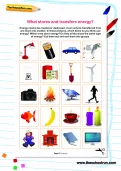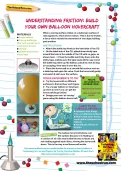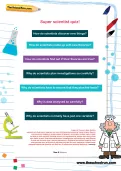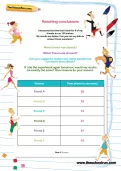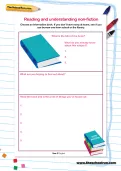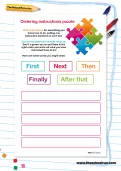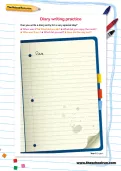The two different ways of spelling this word are for two different meanings. If you’re talking about the place there it’s THERE. If it’s something belonging to someone (e.g. their house) it’s THEIR. Remember the difference by thinking there has the word 'here' in it. See if you can put the correct spelling of their/ there into these sentences.
or
Register to add to your saved resources
Already a subscriber? to view this content.
Cut out the cards below and use them to help you plan a story. What happens if you change the order of the cards? Does your story still make sense?
or
Register to add to your saved resources
Already a subscriber? to view this content.
Read these words and use them to fill in the blanks in the sentences. We are practising spelling words with 'igh' and 'i_e'.
or
Register to add to your saved resources
Already a subscriber? to view this content.
Speech marks come at the beginning and end of spoken words when we write them down. Remember to include any commas, question marks or exclamation marks inside your speech marks. Have a go at putting the speech marks in the correct place in these sentences. Then write some things YOU might say. Don’t forget the speech marks!
or
Register to add to your saved resources
Already a subscriber? to view this content.
Choose a sound from two or three of the buckets and see how many words you can make.
or
Register to add to your saved resources
Already a subscriber? to view this content.
Can you think of some words that rhyme? Write them down here then use some of them to write a little poem!
or
Register to add to your saved resources
Already a subscriber? to view this content.
A KS1 worksheet of nonsense words, based on the National Curriculum and created by a phonics expert to get Year 1 children using their phonics skills to decode unfamiliar words.
These robots have such funny names! Can you read them?
or
Register to add to your saved resources
Choose an information book. If you don’t have many at home, see if you can borrow one from school or the library. What is the title of the book? What are you hoping to find out about? What do you already know about this subject? Read the book and write a list of things you’ve found out:
or
Register to add to your saved resources
Already a subscriber? to view this content.
Write the name of one of your friends or someone in your family in each box, and draw a portrait of them. Can you cut the boxes out and put portraits in alphabetical order?
or
Register to add to your saved resources
Already a subscriber? to view this content.
Choose a book that you know really well. Re-read the story. Can you draw and write about the book in the boxes? The setting is the collection of places where your story happens. The plot is what happens in the story. Draw one of the settings from your story and something that happens in your story.
or
Register to add to your saved resources
Already a subscriber? to view this content.
Write instructions for something you know how to do, putting one instruction sentence in each box. Cut out the boxes and muddle them up. See if a grown-up can put them in the right order and work out what you have instructed them to do! Here are some words you might need: first; next; then; finally; after that.
or
Register to add to your saved resources
Already a subscriber? to view this content.
Cut out this shape. Fold along the lines and stick down the flaps to make a cube. Roll the word die, then roll it again. Can you write a sentence with both of those high frequency words in? If you roll the same word twice, can you fit it into your sentence twice? Then write your sentences down.
or
Register to add to your saved resources
Already a subscriber? to view this content.
Can you think of great words or expressions to use in your writing? We’ve made some suggestions for you. What are your favourite words about your feelings? What are your favourite words to describe places? What about describing characters or actions?
or
Register to add to your saved resources
Already a subscriber? to view this content.
Can you think of some synonyms for these words? Synonyms are words with similar or identical meanings. You can look for synonyms in a special reference book called a thesaurus.
or
Register to add to your saved resources
Already a subscriber? to view this content.
Think of a character from a story that you know well (you’ll find a few suggestions here, do you recognise them?). What is your character’s name? Draw their picture! What happens to them at the start of the story? What happens to them at the end of the story?
or
Register to add to your saved resources
Already a subscriber? to view this content.
Can you write a diary entry for a very special day? When was it? What did you do? What did you enjoy the most? Who was there? What did you eat? How did the day end?
or
Register to add to your saved resources
Already a subscriber? to view this content.
Think up your own character that you might like to write a story about. Draw a picture of your character in the frame, answering questions like: How old is your character?; What is your character's name?; What's something they might say? If it helps, think about some of the characters you like from stories and why you like them.
or
Register to add to your saved resources
Already a subscriber? to view this content.
Sammy has had a spelling test today. Some of the words he has written correctly, others he has got wrong. Can you put a tick next to the words he has spelled correctly and help him by writing the wrong words out properly below?
or
Register to add to your saved resources
Already a subscriber? to view this content.
Borrow some books from the library or a friend, then choose your four favourites. Why did you like them best? Ask your mum, dad or another adult to be your scribe (write for you) and explain why you enjoyed them. Or why not set up a book club with your friends to discuss your book choices?
or
Register to add to your saved resources
Already a subscriber? to view this content.
Get your magnifying glass out and put on your thinking cap: it’s time to be a detective! Why do these characters behave the way they do? Think about their feelings and suggest an explanation. Write it down in the right box.
or
Register to add to your saved resources
Already a subscriber? to view this content.
